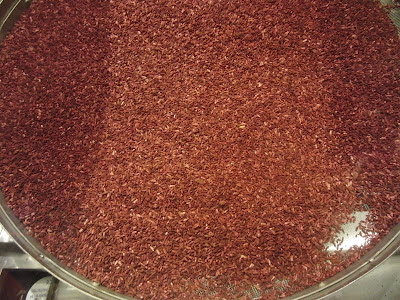Red Yeast Rice (Monascus purpureus) is a species of mold that is purplish-red in color.
This fungus is most important because of its use. It is usually added into foods, likes "char siu"(honey-roasted pork) , to be a stain in China. Otherwise, red yeast is also used to make wine.
Broth of wine
There is the producing process of red yeast as follows:
Day 1: Inoculate, Load trays, and pile up
Mix the red yeast with rice thoroughly , load it on bamboo plane and pile it up.
Day 1
Day 2: Stir
The hyphae of the red yeast grow very fast. To protect its temperature from getting too high and maintain the humidity of the rice, we have to stir the rice.
Day 2
Day 3: First water immersion
The rice lost a part of water. To let the red yeast grow readily, we have to soak the plane of rice into water to replenish sufficient water.
Day 3
Day 4: Stir
To protect its temperature from getting too high and maintain the humidity of the rice, we have to stir the rice. Just like Day 2.
Day 4
Day 5: Second water immersion
At this moment, read yeast grow extremely fast so we have to replenish sufficient water again.
Day 5
Day 6: Post-mature
After water immersion, we have to stir it often to maintain its humidity and temperature.
Day 6
Day 7: Dehydrate (Final product)
Day 7
From Segura and Brandy's (University of California, Los Angeles) article :
"Statin Content Insufficient to Explain Effect of Red Yeast Rice on Cholesterol
A multitude of studies show that red yeast rice and its preparation, Cholestin have
antihypercholesterolemic effects as well as antihypertriglyceridemic effects (3,5).
However, given that Cholestin has a 0.4% content by weight of statin, the highest
Cholestin dosage administered in these studies (2.4g/d) delivered only approximately 5
mg of lovastatin (monacolin K) per day. In comparison to efficacy evaluations of
lovastatin, comparable levels of cholesterol reduction were seen with dosages of
lovastatin ranging from 20 to 80 mg/d. This suggests that the results seen with treatment
of red yeast rice are likely the combined effects of monacolins, plant sterols, and other
substances in the red yeast rice supplement (1). However, the exact mechanisms by
which the individual components of Cholestin act to reduce cholesterol are unknown.
Nevertheless, as a result of the antihyperlipidemic effects of the Chinese red yeast rice
contained in Cholestin, this supplement has the potential to impact the process of
atherosclerosis (6) and serve as a potent therapy to reduce the risk of cardiovascular
disease."








Good morning, I have some question
ReplyDeleteare all the process is done in a sterile room or not?
how about inoculation process?
Thank you in advance